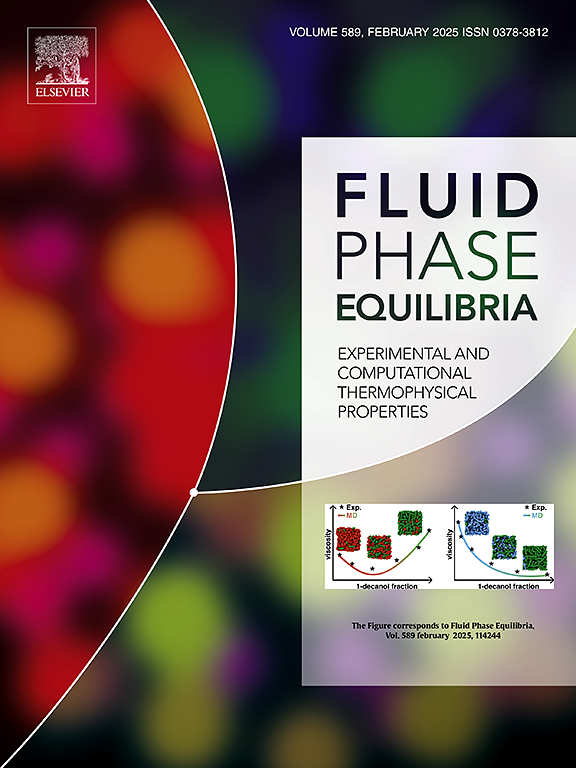作为热力学抑制剂的1,4-环己二酮水溶液中二氧化碳的水合物平衡
IF 2.7
3区 工程技术
Q3 CHEMISTRY, PHYSICAL
引用次数: 0
摘要
在油气输送管道中,水合物的形成带来了严重的管道堵塞风险。注入热力学水合物抑制剂将阻止水合物的形成。采用等共阶加热法研究了1,4-环己二酮作为热力学抑制剂对CO2水合物平衡条件的影响。实验结果表明,1,4-环己二酮能抑制CO2的水合物生成。含有1,4-环己二酮的水溶液有效地将平衡边界向低温高压方向移动。测试数据还表明,随着1,4-环己二酮浓度的增加,CO2水合物平衡压力增加更多。加入15%的CHD,在2.57 MPa下,温度变化达到2.05 K。CHD对二氧化碳水合物形成的抑制作用类似于n-乙基-n-甲基溴化铵和四甲基氯化铵。本文章由计算机程序翻译,如有差异,请以英文原文为准。
Hydrate equilibrium of carbon dioxide in aqueous solutions of 1,4-cyclohexanedione as a thermodynamic inhibitor
In oil and gas transportation pipelines, hydrate formation brings serious pipeline blockage risk. Injecting thermodynamic hydrate inhibitors will prohibit hydrate formation. The effect of 1,4-cyclohexanedione as a thermodynamic inhibitor on hydrate equilibrium conditions of CO2 was studied using isochoric stepwise heating method. The experimental results show that 1,4-cyclohexanedione can inhibit hydrate formation of CO2. Aqueous solutions with 1,4-cyclohexanedione effectively moves the equilibrium boundary to the direction of lower temperatures and higher pressures. The testing data also show that CO2 hydrate equilibrium pressures increased more when the concentration of 1,4-cyclohexanedione increased. The temperature shift reaches 2.05 K at 2.57 MPa by adding 15 wt % CHD. The inhibitory effect of CHD on carbon dioxide hydrate formation is similar to that of n-ethyl-n-methylmorpholinium bromide and tetramethyl ammonium chloride.
求助全文
通过发布文献求助,成功后即可免费获取论文全文。
去求助
来源期刊

Fluid Phase Equilibria
工程技术-工程:化工
CiteScore
5.30
自引率
15.40%
发文量
223
审稿时长
53 days
期刊介绍:
Fluid Phase Equilibria publishes high-quality papers dealing with experimental, theoretical, and applied research related to equilibrium and transport properties of fluids, solids, and interfaces. Subjects of interest include physical/phase and chemical equilibria; equilibrium and nonequilibrium thermophysical properties; fundamental thermodynamic relations; and stability. The systems central to the journal include pure substances and mixtures of organic and inorganic materials, including polymers, biochemicals, and surfactants with sufficient characterization of composition and purity for the results to be reproduced. Alloys are of interest only when thermodynamic studies are included, purely material studies will not be considered. In all cases, authors are expected to provide physical or chemical interpretations of the results.
Experimental research can include measurements under all conditions of temperature, pressure, and composition, including critical and supercritical. Measurements are to be associated with systems and conditions of fundamental or applied interest, and may not be only a collection of routine data, such as physical property or solubility measurements at limited pressures and temperatures close to ambient, or surfactant studies focussed strictly on micellisation or micelle structure. Papers reporting common data must be accompanied by new physical insights and/or contemporary or new theory or techniques.
 求助内容:
求助内容: 应助结果提醒方式:
应助结果提醒方式:


